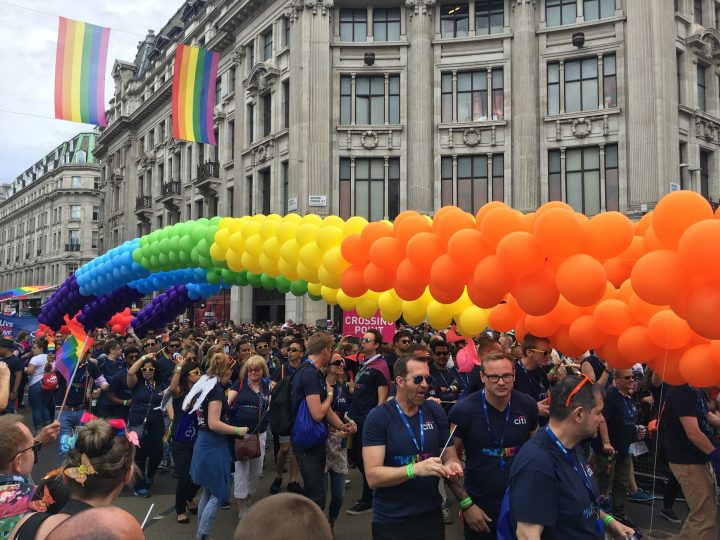Pride season is fully underway in the Northern Hemisphere with huge parades taking place in nearly every major western city. It is a big achievement in a relatively short period of time since the 70s when Pride Marches started out as Gay Liberation protests demanding the decriminalisation of same-sex activity and equal rights. Lesbians and gays marched together with bisexuals, and often the marches were in explicit solidarity with transvestites and people who would today consider themselves to be transgendered; whereas the vast majority of homosexual men and women could blend into the background if they so desired, for a man or woman trapped in the wrong anatomy, blending in was much more problematic.
Thus, was the LGBT movement born. Later on, other categories of sexual identity were also included; the queers, the questioning, the intersexual and the asexual giving us today’s LGBT+ (several variations of which can be seen). Those of us who consider ourselves part of this set of letters cannot keep track of all the latest additions, and new flags seem to be appearing every year!
Despite the huge amount of physical and psychological violence from heterosexuals over centuries towards us – especially in the last century – discrimination has been ever present also WITHIN the LGBT+ collective. Our women have felt marginalised by our men, reflecting the overlapping problems of discrimination against women that exists worldwide and which in reality is a much bigger problem than violence against the LGBT+ collective given the sheer number of women who are killed every year by men in acts of brutal physical violence.
The bisexuals have always been considered as either greedy, or as people who are too afraid to identify as homosexual.
But also within a gender, there are the “straight-acting” gay men who discriminate against the “fems”; and then there is blatant racism, with dating applications full of ignorant human beings whose profiles say things like “No Blacks, no Asians”.
As for the Ts, frequently the Gs and the Ls have a hard time understanding what this transgendered phenomena is, and it’s easy to understand why because the process is so hard, so complicated, so dangerous and so long-lasting, that many of us who are happy with our bodies find it impossible to imagine ourselves in the situation that a trans person finds themselves in. And in this way we repeat the same cycle of discrimination as straight people who find it impossible to imagine having an attraction towards someone of the same sex and are so scared of something different that they immediately dehumanise it and justify their violence.
In Budapest Pride on Saturday an angry group of straight people infiltrated the security cordons set up by the Hungarian police and half way along the route blocked the passage, illustrating the external LGBT+ discrimination we face, and yet internal discrimination was also on display this weekend, this time in London, whose simultaneous Pride March was disrupted by a group of angry Lesbians with messages such as: “Transactivism erases Lesbians,” and, “The trans movement is… coercing lesbians to have sex with men. We firmly condemn this vicious form of anti-lesbianism disguised as progress.”
And all of this goes to illustrate a more profound question. Whereas you can find courses at universities around the world that offer Gender Studies, and while the internet is full of courses and workshops offering people the chance to study their masculinity or femininity, where are the courses, and where are the workshops that allow us to discover what it actually means to be a human being? Where can we learn how to develop our capacity to evolve, to change, to live intentionally and to see what is human in others?
Silo, the spiritual guide from Argentina whose first major public act was a speech in the Andes Mountains called “The Healing of Suffering”, the 50th anniversary of which will be celebrated on the 4th of May 2019 in the small hamlet of Punta de Vacas in Argentina, wrote in his Twelve Principles of Valid Action: It doesn’t matter on which side events have placed you, what matters is that you comprehend that you haven’t chosen any side.
None of us chose our country, our race, the dominant religion in our community or our gender. Therefore, before we start talking about what it means to be a woman or a man, and before we start protesting against other people who have different interpretations and want to do different things with their genitals, can we please have a conversation about what it means to be human?
Because if we can at least have an idea about what it means to be human, we will start to recognise what is human in each other. And in this discovery, we will find that not only will all violence on the basis of gender, sexual orientation and sexual identity disappear, we will also find that all violence against migrants, against the poor and against those with different religious beliefs will also disappear.
And ultimately when we take these discoveries to their conclusions, we will also find that we have no need for nuclear or conventional weapons and war, and we will also realise that unless we stop our environmental violence immediately there will be no planet left on which human life can survive and what it means to be human will no longer be relevant.










